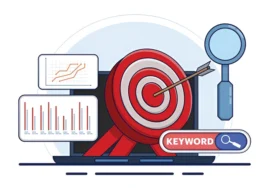
SEO: Are You Making These Common Mistakes?
SEO, or Search Engine Optimization, is a crucial aspect of digital marketing that can impact your website’s visibility and traffic. However, many website owners and marketers make common mistakes that can hinder their SEO efforts. In this blog post, we’ll discuss the most frequent errors and give actionable tips to help you avoid them.
1. Keyword Stuffing
One of the most common SEO mistakes is keyword stuffing. This practice involves repeating keywords throughout your website’s content, often in an unnatural or forced manner. While keywords are essential for search engine optimization, stuffing them can harm your rankings. Search engines have become more sophisticated and can detect keyword stuffing, penalizing websites that engage in this practice.
How to avoid keyword stuffing:
- Use keywords: Incorporate your target keywords into your content in a way that makes sense and flows.
- Focus on quality content: Create high-quality, informative, and engaging content that provides value to your audience.
- Use keyword research tools: use tools like Google Keyword Planner, SEMrush, or Ahrefs to find relevant keywords and their search volume.
- Pay attention to keyword density: Aim for a keyword density of around 1-2% in your content.
2. Neglecting Mobile Optimization
With the increasing number of mobile users, it’s crucial to make sure that your website is mobile-friendly. Google has prioritized mobile-first indexing, meaning that search engines crawl and index the mobile version of your website first. If your website is not optimized for mobile devices, it may rank lower in search results.
How to optimize your website for mobile:
- Use a responsive design: make sure that your website adapts to different screen sizes and resolutions.
- Test your website on mobile devices: check how your website looks and functions on various mobile devices.
- Decrease page load times: Optimize your website’s images and code to reduce loading times.
- Simplify navigation: Make it easy for mobile users to navigate your website.
3. Ignoring Local SEO
If you’re a local business, local SEO is essential for attracting customers in your area. Local SEO involves optimizing your website to rank higher in local search results.
How to improve your local SEO:
- Create a Google My Business profile: Claim and optimize your Google My Business listing with correct information.
- Use local keywords: Incorporate location-specific keywords into your website content.
- Get listed on local directories: give your business to online directories like Yelp, Bing Places, and Yellow Pages.
- Encourage customer reviews: Encourage satisfied customers to leave reviews on your Google My Business profile and other platforms.
4. Not Building Backlinks
Backlinks are links from other websites pointing to yours. They are a crucial factor in search engine ranking. High-quality backlinks from reputable websites can boost your website’s authority and visibility.
How to build quality backlinks:
- Create high-quality content: Produce valuable content others will want to link to.
- Guest posts on other websites: Write guest posts for relevant blogs and websites.
- Take part in online forums and communities: Engage in discussions and share your expertise.
- Reach out to influencers: Build relationships with influencers in your industry and ask them to link to your website.
5. Forgetting About Technical SEO
Technical SEO refers to the technical aspects of your website that can impact its search engine visibility. Issues like slow page load times, broken links, and duplicate content can negatively affect your SEO.
How to address technical SEO issues:
- Optimize page load times: Use tools like Google PageSpeed Insights to identify and fix performance issues.
- Fix broken links: Regularly check your website for broken links and fix them.
- Create a sitemap: Submit a sitemap to search engines to help them crawl and index your website’s pages.
- Use HTTPS: Implement HTTPS to secure your website and improve user trust.
6. Not Tracking and Analyzing Your Results
To measure the effectiveness of your SEO efforts, it’s essential to track and analyze your website’s performance. This includes monitoring your website’s rankings, traffic, and conversions.
How to track your SEO results:
- Use Google Analytics: Track your website’s traffic, user behavior, and conversions.
- Use Google Search Console: Monitor your website’s search performance, including impressions, clicks, and average position.
- Set goals: Define specific goals for your SEO efforts and track your progress.
7. Ignoring User Experience (UX)
While SEO is crucial for improving your website’s search engine visibility, it’s equally important to focus on user experience (UX). A poor user experience can negatively impact your website’s bounce rate, time on site, and conversions.
How to improve your website’s UX:
- Make your website easy to navigate: Use clear and intuitive navigation menus.
- Optimize page load times: Ensure your website loads quickly to keep users engaged.
- Provide high-quality content: Create content that is informative, engaging, and valuable to your audience.
- Use clear and concise language: Avoid jargon and technical terms that may confuse users.
- Mobile-first design: Ensure your website is optimized for mobile devices.
8. Not Updating Your Content Regularly
Fresh and updated content is essential for SEO and user engagement. Outdated content can lead to lower search engine rankings and a poor user experience.
How to keep your content fresh:
- Create new content regularly: Publish new blog posts, articles, or other types of content consistently.
- Update existing content: Review and update your older content to ensure it is accurate and relevant.
- Use evergreen content: Create content that is relevant and valuable for a long time.
9. Overlooking the Importance of Social Media
Social media can be a powerful tool for promoting your website and driving traffic. Sharing your content on social media platforms can help increase your website’s visibility and reach.
How to leverage social media for SEO:
- Share your content on social media: Regularly share your website’s content on platforms like Facebook, Twitter, LinkedIn, and Instagram.
- Encourage social sharing: Add social sharing buttons to your website to make it easy for users to share your content.
- Engage with your audience: Respond to comments and messages on your social media channels.
10. Not Considering Voice Search
Voice search is becoming increasingly popular, and it’s essential to optimize your website for voice search queries. Voice search queries are often longer and more conversational than traditional text-based searches.
How to optimize for voice search:
- Use natural language: Create content that uses conversational language and answers common questions.
- Optimize for local search: If you’re a local business, optimize your website for local voice search queries.
- Use schema markup: Implement schema markup to help search engines understand your content and provide more relevant information to users.
11. Ignoring the Importance of Analytics
Analytics are essential for tracking the success of your SEO efforts and identifying areas for improvement. By using analytics tools, you can gain valuable insights into your website’s traffic, user behavior, and conversions.
How to use analytics:
- Set up Google Analytics: Track your website’s traffic, user behavior, and conversions.
- Track your keyword rankings: Use tools like Google Search Console to monitor your website’s rankings for target keywords.
- Analyze your website’s performance: Identify areas where you can improve your website’s user experience and SEO.
Conclusion
SEO is an ongoing process that requires continuous effort and attention. By avoiding these common mistakes and implementing the strategies outlined here, you can improve your website’s search engine rankings, attract more organic traffic, and achieve your digital marketing goals.





